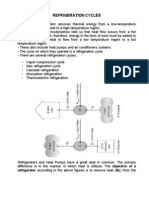UOFe Assignment II
Uploaded by
Sahar Batool QaziUOFe Assignment II
Uploaded by
Sahar Batool QaziAssignment – II
Palm oil derivative products are used in various food applications. Palm oil first of all converted
in to Distilled fatty acid, Light distilled fatty acid and glycerol. The detailed process flow
diagram is available along the assignment. The detailed process conditions are also given.
Considering the process condition you are supposed to develop the cooling system for the
given process. First of all you will divide the cooling load in two types of cooling tower
1. Clean water cooling tower
2. Dirty water cooling tower (Contains small amount of fatty oil).
The CTW utilizes for condense the steam in vacuum ejectors is connected with Dirty water
cooling tower system. The steam use in vacuum ejects is available at 4 bar pressure. And the
CTW use in heat exchangers or for indirect heat transfer is connected with clean cooling tower.
All the run down products should be send to storage tank at 40⁰C
1. Determine the cooling loads of respective cooling towers.
2. Set the range and approach for respective cooling towers and give the reason of your
optimize value.
3. Determine the cooling loads of respective plants.
4. Calculate the evaporation losses, mass flowrate of CTW,
5. Calculate the blowdown and make water considering CC = 5 and 0.1% of the flowrate of
CTW as random losses.
6. Optimize the type of fill for each CT and give reason for the selection of fill.
You might also like
- 5.Refrigeration and Air Conditioning- Part 1No ratings yet5.Refrigeration and Air Conditioning- Part 122 pages
- 3142_Module 5_Vapour Compression Refrigeration Cycles and Heat Pump Systems_2024No ratings yet3142_Module 5_Vapour Compression Refrigeration Cycles and Heat Pump Systems_202452 pages
- Crude Oil Refining (Crude Oil DistillationNo ratings yetCrude Oil Refining (Crude Oil Distillation12 pages
- Pages From 432912277-Manual-Air-Compresor-Atlas Copco-GA75-2-13No ratings yetPages From 432912277-Manual-Air-Compresor-Atlas Copco-GA75-2-134 pages
- Carrier HVAC Handbook Part 7 Refrigeration Equipment100% (3)Carrier HVAC Handbook Part 7 Refrigeration Equipment71 pages
- Refrigeration and Air Conditioning SystemsNo ratings yetRefrigeration and Air Conditioning Systems21 pages
- (Carrier) HVAC Handbook - New Edition - Part.7 - Refrigeration Equipment83% (6)(Carrier) HVAC Handbook - New Edition - Part.7 - Refrigeration Equipment71 pages
- Group A5 - EXP 5 Batch Packed Distillation100% (3)Group A5 - EXP 5 Batch Packed Distillation35 pages
- Safety Interlocks in Crude Heaters Using PLC: Cochin University of Science and Technology KOCHI - 682 022No ratings yetSafety Interlocks in Crude Heaters Using PLC: Cochin University of Science and Technology KOCHI - 682 02275 pages
- F.L.lansing - Computer Modeling of LiBr - VAR SystemNo ratings yetF.L.lansing - Computer Modeling of LiBr - VAR System11 pages
- Week 11 - Lecture25 - 27Ch11 - Refrigeration CyclesNo ratings yetWeek 11 - Lecture25 - 27Ch11 - Refrigeration Cycles26 pages
- Generalized Equation For Thermophysical PropertiesNo ratings yetGeneralized Equation For Thermophysical Properties5 pages
- NOTES on THE REFRIGERATION CYCLE and Assignment-1No ratings yetNOTES on THE REFRIGERATION CYCLE and Assignment-13 pages
- Operator's Guide to General Purpose Steam Turbines: An Overview of Operating Principles, Construction, Best Practices, and TroubleshootingFrom EverandOperator's Guide to General Purpose Steam Turbines: An Overview of Operating Principles, Construction, Best Practices, and Troubleshooting5/5 (1)
- Department of Food Engineering Ned University of Engineering and TechnologyNo ratings yetDepartment of Food Engineering Ned University of Engineering and Technology21 pages
- High Pressure and High Temperature Fatty Acid Hydrolysis PlantNo ratings yetHigh Pressure and High Temperature Fatty Acid Hydrolysis Plant1 page
- Department of Food Engineering Ned University of Engineering and TechnologyNo ratings yetDepartment of Food Engineering Ned University of Engineering and Technology14 pages
- Food Enzymology: FD-206 Spring Semester 2021 Second Year Food EngineeringNo ratings yetFood Enzymology: FD-206 Spring Semester 2021 Second Year Food Engineering25 pages
- Department of Food Engineering Ned University of Engineering and TechnologyNo ratings yetDepartment of Food Engineering Ned University of Engineering and Technology11 pages
- Department of Food Engineering Ned University of Engineering and TechnologyNo ratings yetDepartment of Food Engineering Ned University of Engineering and Technology10 pages
- Department of Food Engineering Ned University of Engineering and TechnologyNo ratings yetDepartment of Food Engineering Ned University of Engineering and Technology12 pages
- Course Title: Mechanics of Materials Course Code: MM-205 Year: S.ENo ratings yetCourse Title: Mechanics of Materials Course Code: MM-205 Year: S.E14 pages
- Course Title: Mechanics of Materials Course Code: MM-205 Year: S.ENo ratings yetCourse Title: Mechanics of Materials Course Code: MM-205 Year: S.E15 pages
- Course Title: Mechanics of Materials Course Code: MM-205 Year: S.ENo ratings yetCourse Title: Mechanics of Materials Course Code: MM-205 Year: S.E13 pages
- Course Title: Mechanics of Materials Course Code: MM-205 Year: S.ENo ratings yetCourse Title: Mechanics of Materials Course Code: MM-205 Year: S.E11 pages
- Course Title: Mechanics of Materials Course Code: MM-205 Year: S.ENo ratings yetCourse Title: Mechanics of Materials Course Code: MM-205 Year: S.E17 pages
- Course Title: Mechanics of Materials Course Code: MM-205 Year: S.ENo ratings yetCourse Title: Mechanics of Materials Course Code: MM-205 Year: S.E13 pages
- Course Title: Mechanics of Materials Course Code: MM-205 Year: S.ENo ratings yetCourse Title: Mechanics of Materials Course Code: MM-205 Year: S.E13 pages












































































